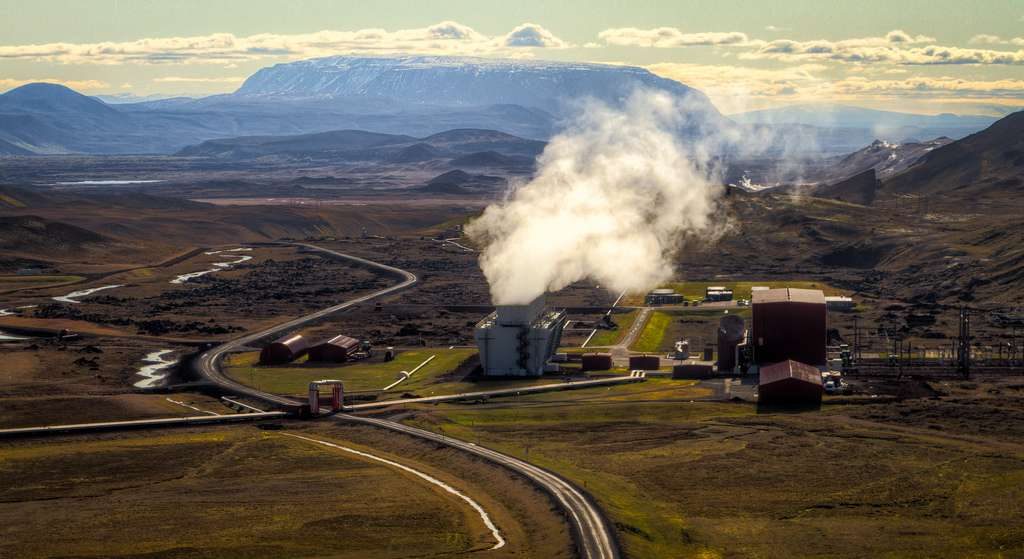Geothermal energy: a power plant in Iceland uses the heat of magma

In 2009, a borehole drilled near the Icelandic geothermal power plant at Krafla reached a magma pocket. Since then, and for two years, superheated water (temperature over 450 ° C) has been used to produce green electricity efficiently. A specialist journal has just published 16 articles on this experience and its implications.
Inaugurated in 1977, the Krafla geothermal power station has since continued to supply electricity to the Icelandic population, with an annual production of 500 GWh (figure from the operator Landsvirkjun ). To do this, 18 wells recover heated water from the bowels of the Earth, which partially transforms into steam when it rises and then travels to the two 30 MW turbines on the site. This success, like that of other similar installations active on the volcanic island, does not prevent the search for ever hotter, even supercritical water, since it carries a greater amount of energyexploitable. This work is carried out under the leadership of a government consortium called the Iceland Deep Drilling Project (IDDP).
Inaugurated in 1977, the Krafla geothermal power station has since continued to supply electricity to the Icelandic population, with an annual production of 500 GWh (figure from the operator Landsvirkjun). To do this, 18 wells recover heated water from the bowels of the Earth, which partially transforms into steam when it rises and then travels to the two 30 MW turbines on the site. This success, like that of other similar installations active on the volcanic island, does not prevent the search for ever hotter, even supercritical water, since it carries a greater amount of energyexploitable. This work is carried out under the leadership of a government consortium called the Iceland Deep Drilling Project (IDDP).
In 2009, the first drilling carried out within this framework was at the center of a certain media agitation. Its objective was to dig a well 4,500 m deep, in order to reach a pocket of supercritical water, therefore maintained at a temperature above 374 ° C and at a pressure of at least 22 megapascals (MPa). However, an astonishing event occurred at 2,096 m depth: the mechanical stresses opposing the drill bit suddenly dropped. After analysis, it turned out that a pocket of magma had been pierced! Previously, such an event had occurred only once in the world, in Hawaii in 2007.
Interesting detail, the magma reached has a temperature between 900 and 1,000 ° C, which has aroused the interest of researchers. Four years later, a complete edition of the journal Geothermics has just been dedicated, under the supervision of Wilfred Elders of the University of California at Riverside (United States), to the scientific and industrial benefits of this discovery. According to him, “the success of this drilling and research projects could revolutionize the energy efficiency of high-temperature geothermal areas around the world”.
Water overheated to 450 ° C for green electricity
What has happened since 2009? The following year, the researchers lowered a steel device to the bottom of the well, where it was cemented near the magma. This structure was perforated on the side of the molten rock and was used to recover water overheated by the presence of magma (temperature above 374 ° C, but pressure below 22 MPa). On the surface, the steam then supplied the turbines at the Krafla power station for two years, until July 2012.
On this occasion, a world record was even broken. This first geothermal installation taking advantage as closely as possible of the heat generated by the magma operated with water heated to more than 440 ° C (enthalpy of 3,200 kJ / kg). The well has still not been reopened since July 2012, since surface installations related to its exploitation require repairs. According to Wilfred Elders, site staff encountered some setbacks, such as accelerated corrosion of certain equipment due to the hydrogen chloride present in the vapor (90 mg / kg). However, the geologist Emeritus noted that these problems had been very informative and that reports on lessons learned from their existence were being written.
In the future, a new borehole to reach supercritical water is planned for 2014-2015. Once again, it will be carried out within the framework of the IDDP, but in the south-west of Iceland, in Reykjanes. Anyway, the tests done at Krafla show that you can drill in a magma pocket while controlling the situation, then take advantage of the molten lava to produce renewable energy with efficiency. Krafla could mark a new era in the exploitation of geothermal resources around the world.